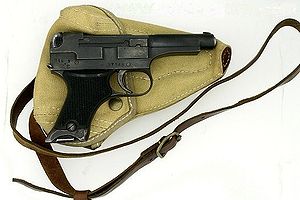- Nambu Type 94 pistol
-
Nambu Type 94 Pistol 
Type 94 PistolType Pistol Place of origin  Empire of Japan
Empire of JapanService history In service 1934 - 1961 Used by See Users Wars Second Sino-Japanese War, Second World War Production history Designed 1934 Manufacturer Nambu Produced 1934 - 1945 Number built 72,000 Specifications Weight 720 g (25.4 oz) Length 180 mm (7.1 in) Barrel length 95 mm (3.74 in) Cartridge 8x22mm Nambu Action recoil operated, locked breech Muzzle velocity 290 m/s (950 ft/s) Feed system 6 round detachable box magazine Sights Iron The Nambu Type 94 8 mm Pistol (Type 94 Handgun, Japanese: 九四式拳銃 Kyūyon-Shiki Kenjū) was a small and light-weight (1 pound 11 ounces) semi-automatic pistol, produced in large numbers by Japan prior to and during the Second World War.
Contents
History
Designed by Kijirō Nambu, the pistol entered production in 1934 at the Nambu Rifle Manufacturing Company. Originally marketed commercially, it is sometimes said to have been developed as a compact pistol intended for pilots, air crews, and tank crews because it was thought that the Type 14 8 mm Nambu Pistol was too large. As such, it was meant to be replaced in IJA service.[1] Indeed, the Type 14 was more than 14mm longer than Colt 1911 .45 ACP. The pistol, which had plastic grips rather than the horn or wood grips of the Type 14, was developed for cheap mass-production, but modifications increased its cost.
Large numbers of the Type 94 were produced for military use. Records were lost during World War II, but it is believed that over 72,000 Type 94 pistols were manufactured. As with most weapons produced by the Axis, quality diminished greatly during the last stages of the war.
Design
The Type 94 used the same 8x22mm Nambu (.315 inch) ammunition as the Type 14 and was easier to load, having a much stronger firing mechanism to reduce misfires. The gun became notorious for a design flaw that allowed it to be fired with a round in the chamber by pressing the exposed trigger bar on the left-hand side of the receiver. The truth however is that the safety, when engaged (as was always to be the case, except immediately before firing), safely and securely blocks the sear bar as well, thereby efficiently preventing any unwanted discharge.
Users
References
- ^ a b "Nambu Type 94 pistol (Japan)". http://world.guns.ru/handguns/hg/jap/nambu-type-94-e.html. Retrieved 2011-02-03.
- ^ a b Paul Alvarez (2003). "Nambu Type 94 Pistol". http://omegacrossroads.com/GunCabinet/Nambu/nambu.htm. Retrieved 2011-02-03.
Japanese Infantry Weapons of World War IIHistory Firearms of JapanSwords Bayonets Side Arms Rifles / Carbines Type 30 · Type 38 · Type 38 Carbine · Type 44 Carbine · Type 97 sniper rifle · Type 99 · Type 99 sniper rifle · TERA rifle · Type 4 Automatic Rifle · Type ISubmachine Guns Light Machine Guns Heavy Machine Guns Grenades Support Weapons Type 93 Flamethrower · Type 100 Flamethrower · Type 10 Grenade Discharger · Type 89 Grenade Discharger · Type 100 Grenade Discharger · Type 2 Rifle Grenade Launcher · Type 97 20mm AT Rifle · Type 4 70mm AT Rocket LauncherCartridges 9mm Japanese · 8×22mm Nambu · 7×20mm Nambu · 6.5×50mm Arisaka · 7.7×58mm Arisaka · 7.7×58mmSR Arisaka Semi-RimmedCategories:- Japanese semi-automatic pistols
- Curio and relic firearms
- 8 mm firearms
- World War II Japanese infantry weapons
Wikimedia Foundation. 2010.
